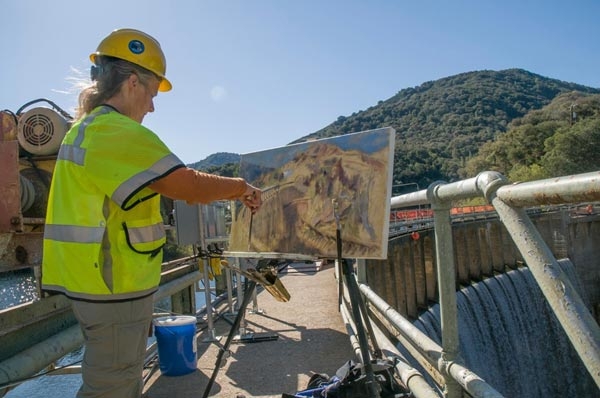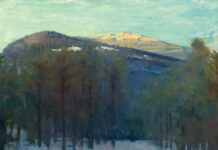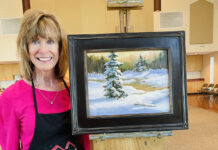Paola Fiorelle Berthoin feels strongly about removing obsolete dams to help a river become free-flowing and healthy, and she’s found a way to help with this. The California artist is painting the progress of the removal of a dam on the Carmel River, raising awareness about the project and its importance.

“Three Views of the Carmel River Reroute Cut,” by Paola Fiorelle Berthoin, oil, 15 x 30 in.
“I’ve been involved in all things having to do with Carmel River watershed since 1989 and one thing has led to another,” says Berthoin. “In 2012 I published Passion for Place: Community Reflections on the Carmel River Watershed — stories, poems, and essays from many people who live here. After that I had been looking around for something to sink my teeth into. And I had been wanting to see what’s going on up there at the dam.”
What was going on was the removal of the San Clemente Dam. Although its removal pleased advocates for the river, the project was motivated more by the decaying infrastructure of the dam, which seemed vulnerable to earthquake-caused catastrophe. Berthoin asked the foreman at the construction company on the job if she could go to the construction site and paint.

Painting on location at the reroute of the Carmel River
The artist may seem like the kind of activist that the construction company and the local water company would like to shun, but Berthoin is more like a tough, pragmatic ambassador. When she went to one part of the work site, she was stunned. “One aspect was hard to swallow — they had to reroute the river and take out a whole section of a mountain, 450 feet long, 200 feet high, and about 70,000 cubic feet of rock. I’m not nuts about the fact that they had to do that, but it was one of the solutions for getting the dam off the river. It’s a large cut and it’s drastic. When you are right there on site you think, my god, what have they done? But in looking at the watershed as a whole, it’s a small piece. The upside is that the dam will be coming off the river. They needed to do something with the silt that had built up behind the dam.”

Berthoin’s setup as she captures the second stage of the dam removal
She resists the water company’s requests to use her images for their own purposes, in part because she doesn’t completely agree with how the project was designed. But her pieces are informing the community and helping keep the conversation healthy. “The dam removal has been a topic around here for quite some time, but even now when I take the paintings out to show the public, they find that they didn’t know what was happening,” says Berthoin. “This is really helping to show people that there is one part that is really drastic, but mostly this is letting the river come back to a natural state. It’s a way of educating people about what’s going on with the project.”

“View From San Clemente Dam,” by Paola Fiorelle Berthoin, oil, 18 x 30 in.
Berthoin says she feels paintings communicate better than photographs in this case. “There is something more tactile about the paintings,” she says. “They are more immediate, not so removed, because the paintings are a personal connection. I am able to make it look more beautiful, and it somehow seems more real. It just resonates with people because of the hand that was creating the paintings. There’s somehow more life in it than with just a photograph.”

“View of Reroute Cut, Looking Downstream Carmel River,” by Paola Fiorelle Berthoin, oil, 18 x 32 in.
The initiative has had its challenges. The construction does not wait for the artist to finish before changing the look of the scene. Berthoin has to plan carefully, as she has a decidedly finite amount of time each session. She is escorted in and out of the construction site. “I have to get moving on it and get it done,” says the artist. “It’s been challenging in that way.”

“View of San Clemente Dam From West Tributary of Carmel River,” by Paola Fiorelle Berthoin, oil, 30 x 30 in. (diptych)
Berthoin says she tries to portray the scene as accurately as possible, taking less artistic license than she normally would with a painting. The main goal is to increase awareness about the viability and advantages of removing dams. “My involvement in this is a soft approach to educating people on the value of water, free-flowing rivers, and river ecology. These paintings provide a platform for educating people further on all these issues.” She has shown the paintings at community meetings about the dam, at Earth Day events, and in similar scenarios. Berthoin hopes to gather all the work for a big show at a large venue, but currently, she is preparing for a show at the Garland Ranch Regional Park’s visitor center. Her dam paintings will be on view there from July 12 through November.

Berthoin painting on Radio Tower Hill. Photo by Jeffery Luhn
Berthoin is a working artist, but it’s clear that this is a project close to her heart. She paraphrases what a Native American once said to her about rivers and dams. “A dam on a river is like a tourniquet on the arm. It constricts the blood, and if it is kept on there long enough, the lower arm is going to fall off. That’s what dams do over time — they kill rivers.”





I somehow missed where I can find the schedule for the convention…
I needed to see this article again and somehow a painting that is not mine is embedded in the article. Can it be removed? It is the third one of the cement river environment.
Hi Paola! I’m happy to update this for, but I’m not sure exactly which image it is and want to make sure. Could you tell me, for example, what the caption is with the wrong painting? Thank you so much!